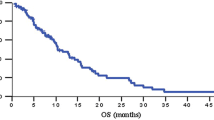Abstract
Gemcitabine is a chemotherapy agent with efficacy in the treatment of lung, pancreas, bladder and breast cancer. It inhibits DNA synthesis by interfering with cytidine triphosphate production and also inhibits the activity of ribonucleotide reductase. Gemcitabine may potentiate fluorouracil's inhibition of thymidylate synthase. This inhibition would be expected to be sequence dependent, occurring only if gemcitabine were administered following fluorouracil (5FU).
The combination of leucovorin, 5-FU, and gemcitabine was assessed in this phase I trial. Eligibility requirements included refractory solid tumor malignancy; adequate hematologic, renal and hepatic reserve; no prior therapy with the combination of leucovorin and 5FU, or with gemcitabine; ECOG performance status 0–2, and signed informed consent.
Eleven men and nine women were eligible. The median age was 52.5 years and the median performance status was 1. All but three patients had prior chemotherapy. The starting doses were leucovorin 20 mg/m2, 5FU 255 mg/m2 and gemcitabine 600 mg/m2. 5FU and gemcitabine were escalated in tandem to 340 mg/m2 and 800 mg/m2 and thereafter to 425 mg/m2 and 1000 mg/m2, respectively. Gemcitabine administration always followed that of 5FU by 30 minutes. The median number of cycles was 2 (range 1–32). Two patients at the starting dose had disease progression within the first cycle with one death on day 28. One patient with cholangiocarcinoma had a partial response and remained on study for 40 months. There were no other responses.
The maximum tolerated dose is leucovorin 20 mg/m2, 5FU 340 mg/m2, and gemcitabine 800 mg/m2. The impact of drug sequence remains undetermined.
Similar content being viewed by others
References
Abratt RP, Bezwoda WR, Falkson G, Goedhals L, Hacking D, Rugg TA: Efficacy and safety profile of gemcitabine in nonsmall-cell lung cancer: a phase II study. Journal of Clinical Oncology 12(8): 1535–1540, 1994
Anderson H, Lund B, Bach F et al.: Single agent activity of weekly gemcitabine in advanced non-small-cell lung cancer: a phase II study. J Clin Oncol 12: 1821, 1994
Carmichael J, Possinger K, Phillip P et al.: Advanced breast cancer: a phase II trial with gemcitabine. Journal of Clinical Oncology 13: 2731–2736, 1995
Burris HA, Moore MJ, Andersen J: Improvement in survival and clinical benefit with gemcitabine as first line therapy for patients with advanced pancreas cancer. A randomized study. J Clin Oncol 15: 2403, 1997
Casper E, Green M, Kelsen D, Heelan R, Brown T, Flombaum C, Trochanowski B, Tarassoff P: Phase II trial of gemcitabine (2,20-difluorodeoxycytidine) in patients with adenocarcinoma of the pancreas. Investigational New Drugs 12: 29–34, 1994
Heinemann V, Xu Yi-Zheng, Chubb, Sherri, Sen, Alina, Hertel, Larry W, Grindey, Gerald B: Cellular elimination of 20,20-difluorodeoxycytidine 50-triphosphase: A mechanism of self-potentiation. Cancer Research 52: 533–539, February 1992
Plunkett W, Huang P, Xu Y-Z, Heinemann V, Grunewald R and Gandhi V: Gemcitabine: metabolism, mechanisms of action, and self-potentiation. Seminars in Oncology 22: 3–10, 1995
Plunkett W, Huang, Peng, Searcy, Catherine E, Gandhi, Varsha: Gemcitabine: preclinical pharmacology and mechanisms of action. Seminars in Oncology 23-5(10): 3–15, 1996
Baker CH, Banzon J, Bollinger JM et al.: 20-deoxy-20-methylenecytidine and 20-deoxy-20,20-difluorocytidine 50-diphosphates: Potent mechanism-based inhibitors of ribonucleotide reductase. J Med Chem 34: 1879–1984, 1991
Heinemann V, Xu Y-Z, Chubb S et al.: Inhibition of ribonucleotide reduction in CCRF-CEM cells by 20,20-difluorodeoxycytidine. Mol Pharmacol 38: 567–572, 1990
Armstrong RD: Fluoropyrimidine activity and resistance at the cellular level. In: Kessel (ed), Resistance to Antineoplastic Drugs, CRC Press, 1989
Valeriote F and Santelli G: 5-Fluorouracil (FUra). Pharmac Ther 24: 107–32, 1984
Moran RG, Danenberg PV, Heidelberger C: Therapeutic response of leukemic mice treated with fluorinated pyrimidines and inhibitors of deoxyuridylate synthesis. Biochemical Pharmacology 31: 3939–3935, 1982
Moran RG, Keyomarsi K: Biochemical rationale for the synergism of 5-fluorouracil and folinic acid. NCI Monographs 5: 159–163, 1987
Myers CE: The pharmacology of the fluoropyrimidines. Pharmacological Reviews 33(1): 1–15, Mar. 1981
Engstrom PF, MacIntyre JM, Schutt AJ, Douglass Jr. HO: Chemotherapy of large bowel carcinoma - fluorouracil (FU) + hydroxyurea (HU) vs. methyl-CCNU, oncovin, fluorouracil, and streptozotocin (MOF-Strep). American Journal of Clinical Oncology (CCT) 8: 358–361, 1985
Kao AK, Muggi FM, Dubin N, Lerner WA, Stark R, Wernz JC, Speyer JL, Blum: Evaluation of a sequential 5-FU and hydroxyurea combination in advanced bowel cancer. Cancer Treatment Reports Vol. 68: 1383–1385, 1984
Muggia FM, Moran RG: Treatment of colon cancer based on biochemical modulation of fluoropyrimidines by hydroxyurea. Seminars in Oncology, Vol. 19(3): 90–93, 1992
Walsh C, Speyer JL, Wernz JC et al.: Trial based on biochemical modulation of 5-fluorouracil by daily sequential hydroxyurea in colorectal cancer. Proc Am Assoc Cancer Res 26: 168, 1985
Vokes EE: Fluorouracil modulation in head and neck cancer. In: Rustum YM (ed), Novel Approaches to Selective Treatments of Human Solid Tumors - Laboratory and Clinical Correlation, Plenum Press, New York 1993
Ren Q-F, Grem JL: Synergistic cytotoxicity & induction of parental DNA fragmentation with sequential gemcitabine & 5-fluoro-20deoxyuridine in HT29 colon cancer cells. National Cancer Institute-Navy Medical Oncology Branch, National Naval Medical Center, Bethesda, MD AACR, Vol 36: 2421, 1995
Schulz L, Schalhorn A, Wilmanns W, Heinemann V: Synergistic interaction of gemcitabine and 5-fluorouracil in colon cancer cells. Klinikum Grosshadern, Medical Clinic III, University of Munich, Institute of Hematology, GSF, Munich, Germany. ASCO, Vol. 17: 965, 1998
Berlin J, Voi M, Alberti D, Arzoomanian RZ, Feierabend C, Morgan K, Simon K, Hardin J, Wilding G: Phase I trial of gemcitabine, leucovorin and 5-fluorouracil in patients with advanced malignancy. ASCO, Vol. 16, 1997
Author information
Authors and Affiliations
Rights and permissions
About this article
Cite this article
Poplin, E., Roberts, J., Tombs, M. et al. Leucovorin, 5-fluorouracil, and gemcitabine: A phase I study. Invest New Drugs 17, 57–61 (1999). https://doi.org/10.1023/A:1006239200772
Issue Date:
DOI: https://doi.org/10.1023/A:1006239200772



